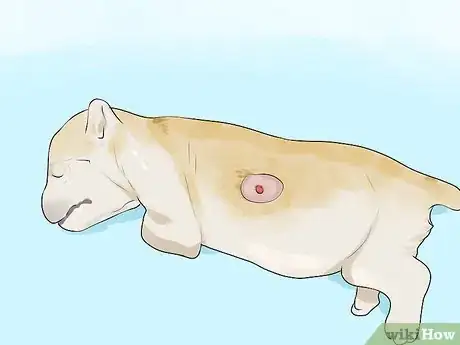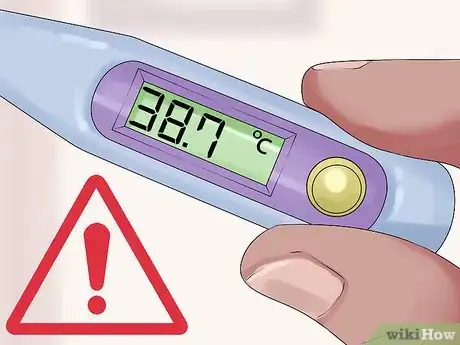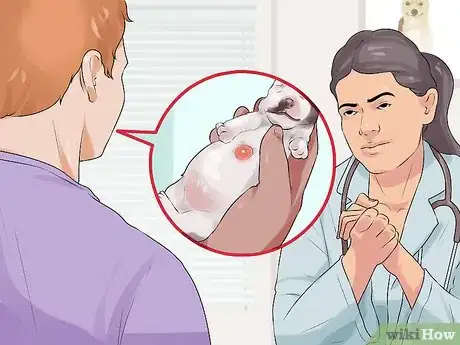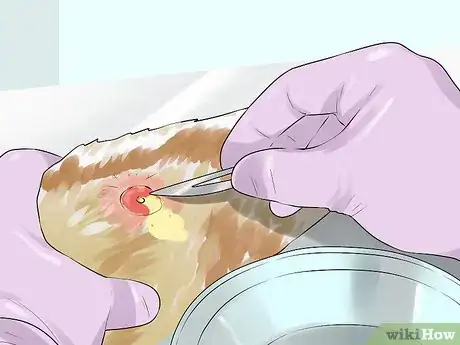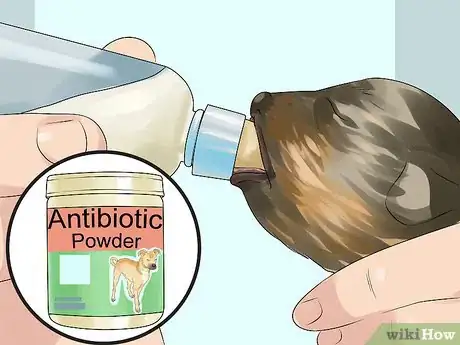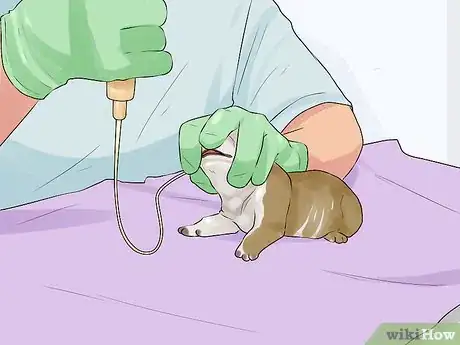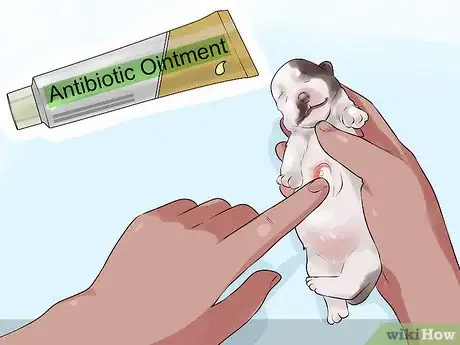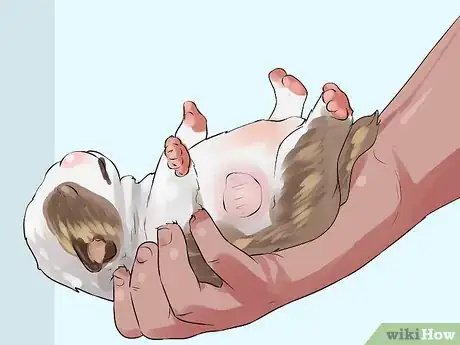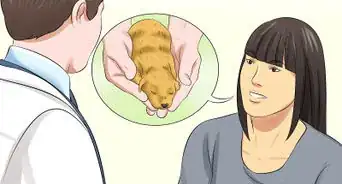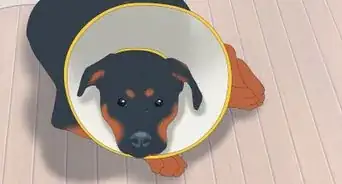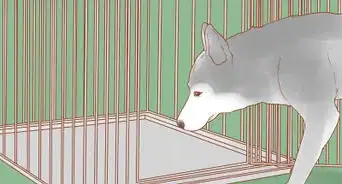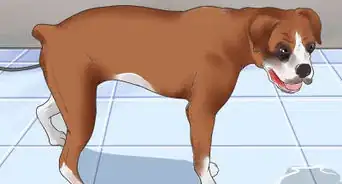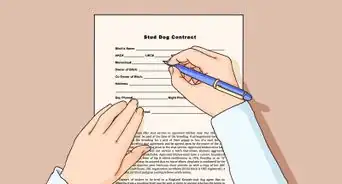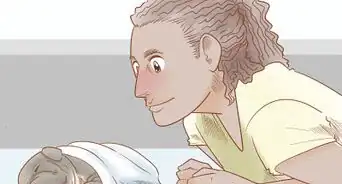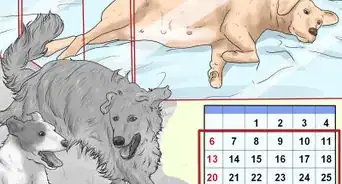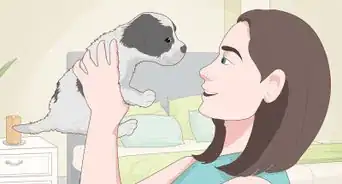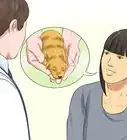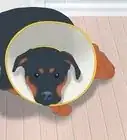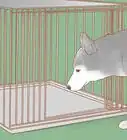This article was co-authored by Lauren Baker, DVM, PhD. Dr. Lauren Baker is a Veterinarian and Assistant Scientist at the University of Wisconsin-Madison. With over 10 years in veterinary medicine, she specializes in the concept of “one health,” which uses insights from veterinary medicine to help human medical research. She holds a Ph.D. in Comparative Biomedical Sciences, a Doctor of Veterinary Medicine, an MS in Comparative Biomedical Sciences, and a Bachelor’s degree in Psychology from the University of Wisconsin-Madison.
This article has been viewed 39,317 times.
Newly born puppies face a variety of challenges in their first days and weeks of life. One somewhat common challenge is the growth of infections and abscesses. If untreated, abscesses can be a serious malady and threaten the life of newly born puppies. However, by learning to properly identify abscesses, treat them, and care for the puppy after treatment, you’ll be able to deal with abscesses and increase the chance of a puppy surviving its first weeks.
Steps
Identifying Abscesses
-
1Look for a red and enlarged area. Redness and enlarged areas of skin are the most common symptom of abscesses. Abscesses may appear as early as the first week after birth. While abscesses may start small and may not cause you much worry, they can quickly grow and threaten the puppy’s life. When examining red and enlarged areas on a puppy, consider if:
- There is pain associated with the red and enlarged area.
- The enlarged area feels warm or hot to the touch.
- The reddened area grows or worsens over the course of hours or days.
-
2Identify pus buildup. Next to redness, pus buildup and drainage is the most clear sign of an abscess. Ultimately, pus is the outcome of the puppy’s body fighting bacteria that are focused around a wound. When looking at pus, consider:
- If that pus is usually thick and yellowish.
- That depending on the severity of the abscess, pus could have some blood mixed into it.
- That pus may leak out occasionally.
- How the pus could introduce bacteria to other wounds or to other dogs. For this reason, make sure to separate the puppy from its littermates.
Advertisement -
3Look for other signs of infection. There are a variety of signs of infection associated with abscesses. These signs may not be limited to the specific area around the abscess. They may be present in other parts of the body or may radiate outward from the area of infection. Other signs include:
- Lethargy. Any weakness in a puppy is cause for concern and requires prompt medical attention.
- Loss of appetite.
- Fever.
- Red lines or signs of infection radiating outward from the abscess toward other parts of the body.
Treating Abscesses
-
1Consult your vet. After identifying an abscess on a newly born puppy, you’ll need to consult your vet for guidance about treatment. Only a trained veterinarian will be able to diagnose and treat abscesses that may threaten the puppy’s life. This is especially true since puppies are very vulnerable during their first days and weeks alive.
- Your veterinarian will physically examine the puppy.
- The veterinarian may run some diagnostics, such as blood work, on the puppy.
- Your veterinarian may also take a swab of the pus and culture it to see what type of bacteria is causing the abscess.[1]
-
2Drain the abscess. Draining is one of the most common ways to treat abscesses for newborn pups and adult dogs alike. By draining, the vet will allow the pus to vacate the wound. Ultimately, this helps the body to heal. In addition, it relieves pressure and associated pain that the puppy may be suffering.
- The veterinarian will take a scalpel and lance the abscess. This means they will make a small incision that will allow the abscess to drain built-up pus.
- Draining will reduce the size of the abscess.
- Draining may need to be repeated several times over the next couple of days.
-
3Administer medications prescribed by your veterinarian. After draining the abscess, your vet will prescribe antibiotics. Antibiotics are almost always needed to fight the infection that made the abscess possible in the first place. Depending on what caused the infection, your vet may prescribe other medications in addition to antibiotics, such as steroids.
- Antibiotics courses usually run 7 to 10 days.
- Antibiotics for puppies generally come in a powdered form that you can mix into their formula.
- Avoid missing any doses. In addition, administer the proper amount.
- Your vet will likely prescribe a broad-spectrum antibiotic that will focus on fighting staph infections.[2]
- If the abscess was caused by juvenile cellulitis (or “puppy strangles”), your vet will prescribe a steroid in addition to antibiotics. Administer the steroid according to your vet’s instructions.[3]
- Do not suddenly stop giving any medications without consulting your vet.
Providing Aftercare
-
1Tube feed the puppy, if necessary. Very young puppies may need to be tube fed after being treated for their abscess. This is because newborn pups are very susceptible to infection and need sustenance to fight infection.
- To tube feed, you’ll need a tube feeding kit that includes a syringe and a 16-inch (41 cm) tube. Your vet will likely supply you with a kit.
- If you’ve never tube fed an animal before, ask your vet to show you how it is done and give you detailed instructions.
- Tube feeding must be done every two to three hours until the puppy has shown visible signs of recovery – and can nurse on its own.
- You may tube feed the puppy its mother’s milk or formula – depending on what your vet recommends.[4]
-
2Keep the infected area clean. After initial treatment, you need to make sure that the infected area stays clean. Ultimately, the introduction of new bacteria could result in persistent infection and the death of the newborn puppy.
- Apply antibiotic ointment or other topical medications as prescribed by your vet.
- Change bandages and use disinfectant regularly.
- Take steps to make sure the wound is dry.
- Prevent the puppy from licking or otherwise irritating the wound. For instance, you may need to use an Elizabethan collar (a large cone-like collar) on puppies who are large enough. For smaller puppies, bandages might be enough to protect the wound.[5]
-
3Watch for signs of improvement. The days after initial treatment are critical in ensuring the puppy’s eventual recovery from infection. Thus, you need to be diligent and monitor the puppy’s overall health and, of course, the wound itself. Consider:
- The puppy’s general energy level after treatment. The puppy should begin to bounce back as soon as a day after treatment begins. Within 3 or 4 days, the puppy should clearly be on the road to recovery
- Continued signs of infection.
- If the wound is healing itself. After being drained several times, the wound should no longer fill up with pus and should begin to heal. If the abscess persists after 2 or 3 days, consult your veterinarian again.[6]
References
- ↑ http://www.dogbreedinfo.com/breedingdogs/whelpingabscesspuppy.htm
- ↑ http://leerburg.com/savepup.htm
- ↑ http://www.veterinarypartner.com/Content.plx?A=2906
- ↑ http://www.dogbreedinfo.com/breedingdogs/whelpingabscesspuppy.htm
- ↑ http://www.dogster.com/lifestyle/dog-health-dogs-abscess-treatment-at-home
- ↑ http://dogsarena.com/treating-dog-abscesses-dog-abscess/
About This Article
If you've noticed signs of abscesses on your newborn puppy, like a red, enlarged area that may be hot or have pus buildup, take it the vet right away so they can diagnose it and recommend a treatment plan. Once your puppy has been diagnosed, the vet may drain the abscess to help it heal. Additionally, the vet may give you antibiotic powder to mix into your puppy’s formula, which will help it fight the infection. Make sure you give your puppy the full round of antibiotics, even if it gets better, so the infection doesn’t return. To learn how to keep your puppy healthy after receiving treatment, read more from our Veterinary co-author.
